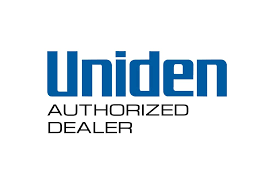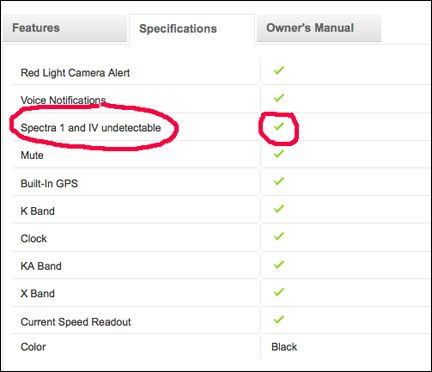
Updated: January 2nd, 2018* by RadarBusters' Staff
In January of 2015, during the Las Vegas Consumer Electronics Show (CES), Uniden announced their release of three new Uniden radar detectors, the Uniden LRD450, LRD750, and the LRD-950.
In 2016, Uniden introduced successors to these models--the Uniden DFR6, and GPS-based Uniden DF7.
For 2017, Uniden has redefined what is possible in detection performance with the highest performing detectors ever seen, the Uniden R1 and Uniden R3.
(Updated 01/02/2018)
Uniden's History in the Radar Detector Business
Uniden is the company that pioneered the integration of GPS technology into radar detectors
Uniden's first entry into GPS radar detector integration

Uniden GPS RD, Introduced 2001
In 2001, Uniden released the first detector of its kind, the Uniden GPSRD, a detector that had GPS capability. The product concept was cutting edge. But unlike today, the ability to leverage GPS technology was limited by certain circumstances at the time.
Unlike GPS integration that is common today--including the WAZE smartphone app, TomTom and Garmin navigation systems, and other GPS radar detectors--this early Uniden GPS radar detector did not have an integrated photo enforcement database as it wasn't needed at the time. Photo enforcement didn't make its first appearance in the United States until four years later, in 2005.
The only real benefit of the Uniden GPSRD was that it would provide you with your exact GPS coordinates, as consumer GPS technology and high-end CPU processing capacity was still in its infancy at that time. The GPSRD did not provide the ability to filter out false alerts based upon GPS locations.
It's also important to point out that GPS accuracy had been restricted by the government, until later in the year of 2000. Even so, in terms of GPS integration into a radar detector, the GPSRD was way ahead of its time.
That's not to say that the GPSRD wasn't without fault, however.
One major problem is it leaked RF (radio frequency) like a sieve, causing interference with ground based satellite transmitters and receivers.
It was so bad that in the fall of 2003, Radar Roy got a phone call from an ESPN engineer.
He explained that they were set up at the University of Phoenix sports complex getting ready to uplink Cardinals football game, and he was suspecting that a car was in the parking lot that had a radar detector which was interfering with their uplink and “begged” me to come out with my Spectre RDD to locate the vehicle.
So Roy packed up his SPECTRE, jumped on his Harley and was met by security at the gate and began driving around the parking lot. In about five-minutes he located the car, and hanging on the windshield was a Uniden GPSRD.
Shortly after this the FCC came down with stiff regulations which limited the emissions of radar detectors and soon after Uniden chose to leave the radar detector manufacturing business to focus on other more popular selling items, such as their scanners and CB radios.
Uniden's second entry into GPS radar detector integration
Then a few years later, Uniden decided to get back into the game by announcing the Uniden MapTrax during the 2007 CES show.

Uniden MapTrax, Introduced 2007
While the Uniden MapTrax consisted of two separate units, one for radar and one for GPS/navigation (connected by a cable), several years later, Escort released their own fully integrated one-piece GPS navigation/radar detector with similar features to the Uniden MapTrax. Despite the novelty of the MapTrax, the model was eventually discontinued.

Passport iQ, Introduced 2010
The Escort Passport iQ also proved not to be much of a commercial success, either, and it too was eventually withdrawn from the marketplace.
Looking back at this period, it appears that the consumer marketplace simply rejected products consisting of a primary GPS navigation device with radar detection abilities even if it was built-in to the device as was the case with the iQ. Perhaps that and the fact that the mainstream consumer GPS navigation manufacturers of TomTom and Garmin (with DriveAssist) had already been offering GPS navigation devices which incorporated photo enforcement databases and real-time traffic reporting for little or no additional costs made the utility of an all-in-one device less compelling and overly complicated for the consumer to understand.
Uniden's third entry into GPS radar detector integration
In 2015, Uniden announced that they were going to make their third entry into the radar detector niche by releasing their Uniden LRD-450, LRD-750, LRD-850, and LRD-950 radar detectors. The latter model, the LRD-950 was a radar detector with GPS capabilties built-in.
Unlike the earlier MapTrax and Passport iQ models, both of which were not commercially successful, these newer Unidens were primarily radar detectors first and foremost with GPS capabilities enhancing their detection performance as opposed to a GPS navigation system with radar detection capabilities added on.
This approach clearly proved to be more commercially viable as all of the major radar detector manufacturers today incorporate GPS capabilities in their radar detectors, similarly.
Overview of the Uniden LRD-950 Radar Detector
On Unidens’ website, they promoted their LRD-950 as their top of the line “Super Long Range” radar detector with a built in GPS enabling you to “mark geographical points where you commonly encounter radar transmissions”.

They also claimed that this detector, along with their LRD450 and LRD750 were undetectable to the Spectre RDD.

They also claim that their built in GPS has red light camera and speed camera alerts.
The retail price for the Uniden LRD950 on the Uniden website is $399.00, about $50 dollars cheaper than the retail price of the Escort 9500ix a popular detector selling at the time.
First Impressions of the Uniden LRD-950 Radar Detector
Roy's first impressions when taking the Uniden LRD-950 out of the box were positive.
It used the same RJ-11 power connection, had an audio jack, a USB port and came packaged in a travel case.
What was different was that the LRD-950 had a larger OLED display which was much easier to read than the smaller 9500ix's blue display.
OLED Display – Pass
The one thing Roy really liked about the Uniden LRD950 was the main OLED display of the detector.
It was very easy to read, even in bright sunlight, it also displayed the time right in the center.
However, one thing he did not like about the display was its five little LED lights under the main OLED display that serve as the signal strength meter.
They are very small and they are very hard to see while driving in bright sunlight.
Voice Alerts - Pass
The Uniden LRD-950 has voice alerts that are easy to hear and understand. It alerts you to the type of speed measurement threat that is being displayed.
Spectre RDD Performance – Fail
Roy first wanted to confirm Uniden’s claim that their new radar detectors’ were “undetectable” to the Spectre I and 4. He got his two Spectre units from my arsenal of testing equipment.
After powering on the LRD950, Roy allowed it to go through its power on testing feature. The Spectre 1 lit up like a Christmas tree, the exact same thing happened when he tested the LRD950 against his Spectre 4.
However Roy was due for bit of a surprise.
During range testing of the Spectre he was unable to detect the Uniden further away than 25 feet. (It should be noted that Stealth MicroSystems had offered a free update for the Spectre I shortly after its release to the Spectre II. Because of this it is unknown if any Spectre I units are still in use today)
During range testing of the Spectre 4, he received a number of intermittent warnings as far away as 500 feet, but for the most part it was silent at distances further then 30 to 35 feet.
So even though the Uniden fails at being 100% Spectre proof, this is the best detector outside of Escort's M3 series in defeating the Spectre.
Mark Locations – Fail
Roy soon discovered that Uniden’s marketing claim that you are able to “mark geographical points where you commonly encounter radar transmissions” may mislead someone to believe that this feature is similar to Escort’s auto learn feature, where their detectors are able to lock out known false alert locations, its not!
All it is able to do is mark a location that you may want to be alerted to the next time you're in close proximity.
False Alert Filtering – Pass
Roy was pleasantly surprised of the LRD-950’s ability to filter out false alerts from the adaptive cruise control sensors and other devices that cause false alerts.
During the last two weeks driving and testing this detector Roy noticed one disturbing thing. The lag time for the Uniden LRD-950 to alert to a real constant on K and Ka was as long as two to four seconds behind the REDLiNE and the STiR Plus.
Because of this, he felt it may have a negative impact on the detectors ability to detect quick trigger instant on.
Radar Detector Performance Testing – Pass
(Updated 11/28/2015)
For our initial review we did a number of instant on and constant on radar detector tests with the Uniden LR-D950 and the results we recorded, documented and published on our YouTube channel.
However several other independent reviewers and enthusiasts have had totally different results than what we encountered and documented during our testing.
So because we only had one Uniden LRD-950 for our initial test, which could had been defective, we have decided to upgrade our score to pass and place it in the same category as our 3-star rated detectors.
Does Uniden Strike Out or Get On Base?
(Updated 11/28/2015)
Roy's only major remaining concern with the Uniden LRD-950 is that it was advertised as being stealth to the Spectre, which it wasn't.
However since many respected members of our radar detector community have given the Uniden such high marks and because of its competitive price, Roy decided to "eat a little crow" since his first review and say that they definitely got on base with the Uniden LRD-950 radar detector.
|
|
|